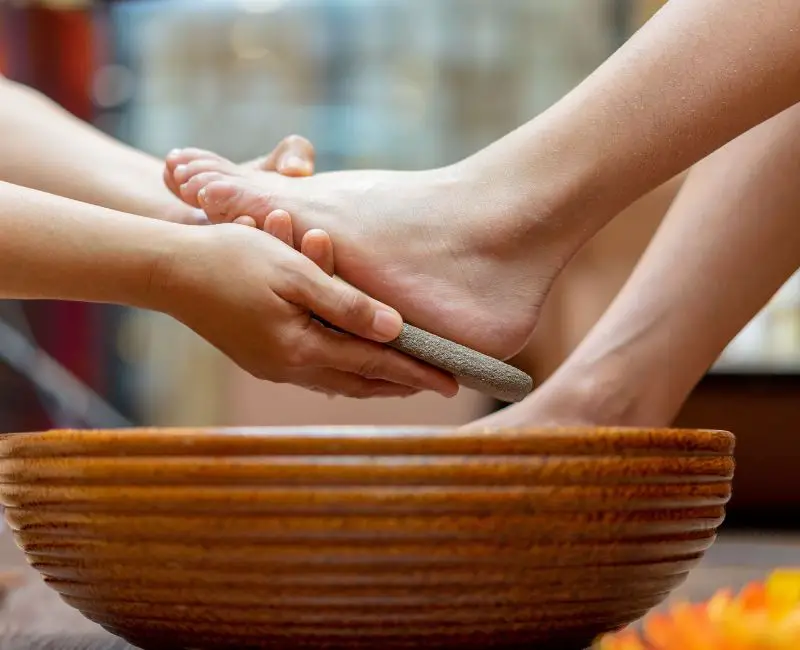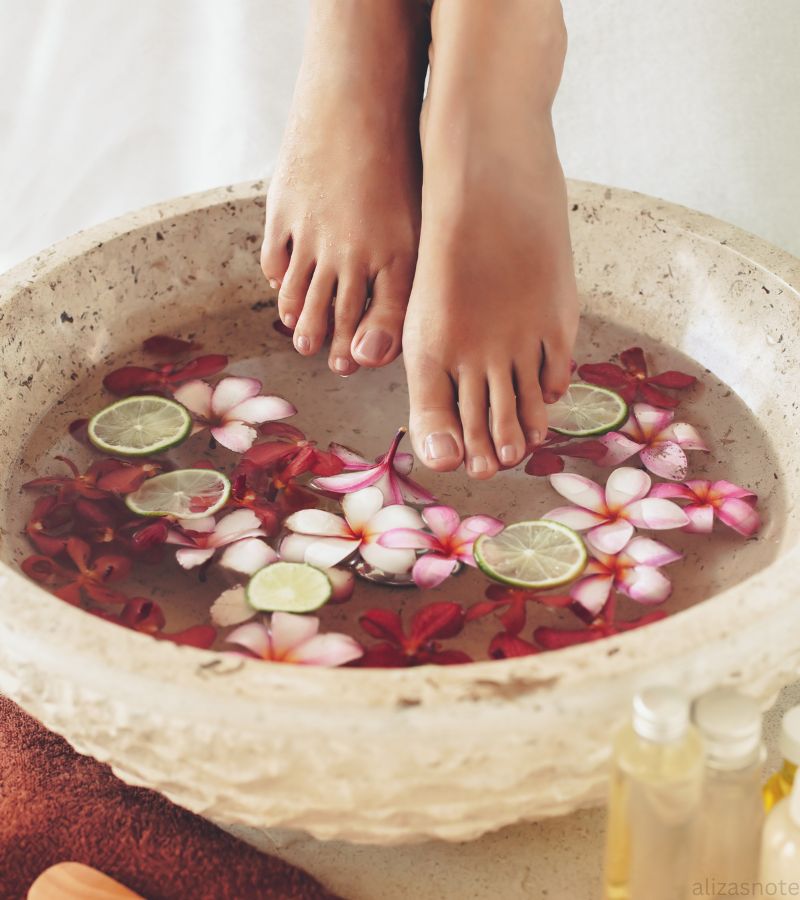Really focusing on your feet is vital for generally wellbeing and solace. Our feet withstand daily wear and tear, often leading to dryness, calluses, and cracked heels.
While professional treatments are available, you can achieve healthy, beautiful feet with a consistent and effective foot care routine right at home.
In this blog, we’ll walk you through simple and practical steps to pamper your feet, prevent common issues, and maintain soft, smooth skin.
Join us on a journey to happier, healthier feet with foot care routine at home and remedies you can perform in the comfort of your own home!
Common Foot Problems:
Our feet endure a lot of stress and strain, making them vulnerable to various issues. Understanding these common foot problems can help you identify and address them effectively, ensuring your feet stay healthy and comfortable.
1. Dry Skin
Causes:
- Lack of moisture
- Harsh weather conditions
- Prolonged exposure to water
Symptoms:
- Rough, flaky skin
- Itching and discomfort
- Cracks and fissures in severe cases
Prevention and Treatment:
- Regularly moisturizing with thick, emollient creams
- Using gentle, hydrating soaps
- Avoiding excessively hot showers
2. Calluses and Corns
Causes:
- Friction and pressure from shoes
- Walking barefoot on hard surfaces
- Ill-fitting footwear
Symptoms:
- Thick, hardened layers of skin
- Pain and tenderness, especially when walking
Prevention and Treatment:
- Wearing properly fitting shoes
- Using protective pads and cushions
- Regular exfoliation and moisturizing
3. Cracked Heels
Causes:
- Dry skin
- Prolonged standing
- Open-back shoes
Symptoms:
- Deep, painful cracks
- Bleeding and infection in severe cases
Prevention and Treatment:
- Daily moisturizing with urea-based creams
- Regular exfoliation with a pumice stone
- Wearing supportive, closed-back shoes
4. Fungal Infections
Causes:
- Moist environments (locker rooms, swimming pools)
- Wearing damp socks or shoes
- Sharing personal items
Symptoms:
- Itching, redness, and swelling
- Blisters and peeling skin
- Thickened, discolored nails (in the case of toenail fungus)
Prevention and Treatment:
- Keeping feet clean and dry
- Using antifungal powders or creams
- Wearing breathable, moisture-wicking socks
5. Ingrown Toenails
Causes:
- Improper nail trimming
- Tight shoes and socks
- Injury to the toenail
Symptoms:
- Agony and delicacy along the nail edges
- Redness and swelling
- Infection in severe cases
Prevention and Treatment:
- Cutting nails straight across, not too short
- Wearing properly fitting shoes
- Soaking feet in warm water and using antiseptics for mild cases
Read Others:
How To Clean Your Feet
How To Keep Feet Healthy
6. Bunions
Causes:
- Genetics
- Wearing tight, narrow shoes
- Arthritis
Symptoms:
- A hard knock on the foot at the foundation of the enormous toe.
- Swelling, redness, and soreness
- Restricted movement of the big toe
Prevention and Treatment:
- Wearing wide-toe box shoes
- Using bunion pads and orthotics
- Surgical intervention in severe cases
7. Plantar Fasciitis
Causes:
- Overuse and strain on the foot’s arch
- High-impact activities
- Obesity
Symptoms:
- Sharp torment in the heel, particularly toward the beginning of the day
- Stiffness and aching in the arch
Prevention and Treatment:
- Extending practices for the feet and calves
- Wearing supportive shoes and insoles
- Resting and applying ice to decrease aggravation
If you experience persistent or severe symptoms, seeking professional medical advice is essential for appropriate treatment and relief.
Foot Care Routine At Home:
Dealing with your feet is urgent for generally wellbeing and solace. A consistent foot care routine at home can prevent common issues like dryness, calluses, and cracked heels. Here’s a step-by-step guide to keep your feet healthy and well-maintained:
1. Soaking Your Feet
Benefits: Soaking softens the skin, making it easier to remove dead cells and calluses. It also provides relaxation and relief after a long day.
How to Soak:
- Fill a basin with warm water.
- Add Epsom salt, vinegar, or a few drops of essential oil for added benefits.
- Soak your feet for 15-20 minutes.
- Pat your feet dry with a clean towel.
2. Exfoliating
Importance: Exfoliation removes dead skin cells, preventing the buildup that can lead to rough, cracked heels.
Tools and Products:
- Pumice Stone: Gently rub the calloused areas.
- Foot Scrub: Apply a scrub with exfoliating particles and massage in circular motions.
How to Exfoliate:
- After soaking, use a pumice stone or foot file on rough areas.
- Apply a foot scrub and massage in circular motions.
- Rinse off with warm water and wipe off.
3.Moisturizing
Role of Moisturizers: Moisturizing is crucial for keeping your skin soft, supple, and crack-free.
Best Ingredients:
- Urea: Softens thick, dry skin.
- Shea Butter: Deeply hydrates sustains the skin.
- Glycerin: Attracts moisture and keeps skin hydrated.
Application Tips:
- Apply moisturizer generously after exfoliating.
- Focus on the heels and other dry areas.
- For best results, apply before bed and wear cotton socks overnight to lock in moisture.
4. Nail Care
Importance: Suitable nail care hinders ingrown toenails and illnesses.
How to Care for Nails:
- Trim nails straight across to avoid ingrown toenails.
- File the edges to smooth out rough spots.
- Push back cuticles gently and hydrate them with cuticle oil or cream.
5. Home Remedies for Common Foot Problems
Cracked Heels:
- Apply coconut oil or shea butter to deeply moisturize.
- Use a homemade foot mask with honey and banana for added hydration.
- Wear cotton socks overnight after applying a thick layer of moisturizer.
Calluses and Corns:
- Soak and exfoliate regularly.
- Use protective pads to reduce pressure.
- Apply lemon juice or baking soda as natural remedies.
Fungal Infections:
- Keep feet clean and dry.
- Use antifungal powders or creams.
- Try antifungal soaks with tea tree oil or apple cider vinegar.
Tips for Healthy Feet:
- Keep feet clean and dry.
- Moisturize daily to maintain skin hydration.
- Wear appropriately fitting shoes to stay away from pressure focuses
- Avoid prolonged periods of standing without breaks.
Regular Foot Care Habits:
- Weekly soaking and exfoliation.
- Daily moisturizing and nail care.
- Regular use of a pumice stone or foot file to keep skin smooth.
If you encounter persistent or severe issues, don’t hesitate to seek professional medical advice.
FAQs:
Q. What are the best foot care at home for cracked heels?
Effective home remedies for cracked heels include soaking your feet in warm water with Epsom salt, exfoliating with a pumice stone, and moisturizing with coconut oil, shea butter, or urea-based creams. Applying honey and wearing cotton socks overnight can also provide deep hydration and aid healing.
Q. How often should I exfoliate my feet?
Exfoliating your feet once or twice a week is usually sufficient to remove dead skin and prevent buildup. Over-exfoliating can lead to irritation, so it’s important to find a routine that suits your skin type.
Q. Can diet affect the condition of my heels?
Yes, a diet lacking essential nutrients like vitamins A, C, and E can impact the health of your skin, including your heels. Staying hydrated and eating a balanced diet rich in these vitamins can help maintain healthy skin.
Q. What type of footwear is best for preventing cracked heels?
Supportive, well-fitting shoes with closed backs are best for preventing cracked heels. Stay away from high heels and shoes that apply unreasonable tension behind you. Select shoes with great padding and curve support.
Q. When should I see a doctor for cracked heels?
Consult a doctor if you experience severe pain, bleeding, persistent cracks despite home treatment, or signs of infection such as redness, swelling, warmth, or discharge. A healthcare professional can provide stronger treatments and address any underlying issues.
Last Call:
foot care routine at home is crucial for keeping your feet healthy and comfortable. By following a regular at-home foot care routine, you can prevent common issues like dryness, calluses, and cracked heels.
With dedicated care and attention, your feet can remain soft, smooth, and healthy. Explore these simple yet effective practices to ensure your feet are well-maintained, and enjoy the comfort and confidence that comes with having well-cared-for feet.
Call to Action:
- Get ready with these effective at-home foot care routine. Your feet carry you through every step of life, so let’s make sure they’re in tip-top shape!
- Spending just a few minutes each day on foot care can lead to healthier, happier feet.
- Share your tips, tricks, and before-and-after photos with us. Join us on Pinterest for more foot care advice and become part of our community of foot care enthusiasts.


